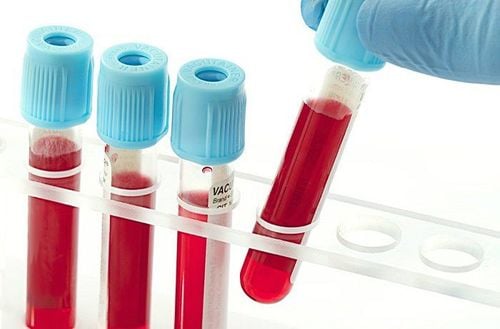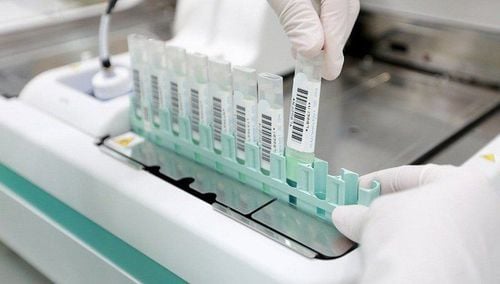This is an automatically translated article.
The ceruloplasmin test is used to determine the amount of ceruloplasmin, a copper-binding substance in the body. It is often indicated for people with manifestations of copper deficiency, Wilson's disease, Menkes syndrome and early screening for Wilson's disease in asymptomatic people.
1. What is Ceruloplasmin?
Ceruloplasmin is a glycoprotein produced in the liver. It is mainly responsible for transporting copper in the blood. Copper is an important substance in the body, responsible for producing energy, forming connective tissue and supporting the activities of the central nervous system.
The ceruloplasmin test is done to determine the amount of ceruloplasmin in the body, especially in the diagnosis of Wilson's disease, a rare genetic disorder. Wilson's disease occurs due to an excessive accumulation of copper in the liver, brain, and other body tissues.
2. Why is the ceruloplasmin test needed?
Ceruloplasmin testing is often ordered in cases of suspected Wilson disease with accompanying symptoms including:
Fatigue Yellowing of the skin or eyes Skin rash Nausea Joint pain Drooling Easy bruising Loss of appetite Anemia Changes in behavior Difficulty controlling movement or difficulty walking. In addition to the ceruloplasmin test, your doctor may order other blood and urine copper tests to confirm the diagnosis. If you've been diagnosed with Wilson's disease, a ceruloplasmin test is often ordered to evaluate how well your treatment is working.
Ceruloplasmin test is also indicated to diagnose Wilson early, in case there is a family history of Wilson's disease even when there are no symptoms of the disease. Symptoms of Wilson's disease usually appear between the ages of 5 and 35, but can appear earlier or later.
If copper deficiency is suspected, a ceruloplasmin test will be ordered. Symptoms of copper deficiency in the body include:
Pale skin Abnormally low white blood cell count Osteoporosis Fatigue Tingling in hands and feet. Children may also be ordered to have a ceruloplasmin test if they have symptoms of Menkes syndrome, including:
Brittle, sparse or tangled hair Difficulty feeding No or slow growth Lack of muscle tone Convulsions . Most children with this syndrome die within the first few years of life, but early treatment can help some children live longer.

Xét nghiệm ceruloplasmin khi người bệnh có kèm triệu chứng buồn nôn
3. How is the ceruloplasmin test done?
The ceruloplasmin test is done by drawing blood from a vein in the arm. The blood will be put into a test tube to be sent to a laboratory for analysis. Once the results are available, your doctor will explain what the test means for you.
4. Are there any risks to having a ceruloplasmin test?
The risks associated with performing a ceruloplasmin test are relatively small, mainly related to the injection site, and include:
Difficulty drawing blood, needing multiple needle punctures Heavy bleeding at the site of blood collection Fainting due to blood loss Subcutaneous coagulation Skin infection at the site of blood collection.
5. What to prepare before the ceruloplasmin test?
Before taking the ceruloplasmin test you do not need to prepare anything. However, ask your doctor if there is anything special to do before having the test in your case.
6. What do ceruloplasmin test results mean?
6.1. Normal limits for ceruloplasmin oral contraceptives or estrogen: 27 - 66 mg/dL Pregnant women: 30 - 120 mg/dL Children 7 months to 3 years old: 31 - 90 mg/dL. The normal range in ceruloplasmin test results can vary slightly between different laboratories.
6.2. Low blood ceruloplasmin levels Low ceruloplasmin levels can be an indicator of Wilson's disease. In addition, it can also be a sign of other diseases such as:
Liver disease Liver failure Cirrhosis Liver malabsorption syndrome Malnutrition Menkes disease Nephrotic syndrome if accompanied by other manifestations such as protein in the urine, low protein in blood, high cholesterol level, high triglyceride level. 6.3. High level of ceruloplasmin in the blood The level of ceruloplasmin in the blood is higher than normal in cases of:
Pregnancy Taking estrogen pills Taking a combined oral contraceptive, which is a type of birth control pill that contains estrogen and progesterone Inflammation or disease cancer.

Hàm lượng ceruloplasmin trong máu cao ở phụ nữ đang mang thai
High ceruloplasmin levels may also be associated with:
Copper toxicity Rheumatoid arthritis (RA) Severe infections Primary cholangitis Systemic lupus erythematosus Lymphoma, such as Hodgkin's disease Leukemia Epithelial cancer.
7. What happens when I get ceruloplasmin test results?
The ceruloplasmin test is not usually used to diagnose most conditions that cause abnormal levels of ceruloplasmin. It is commonly used in the diagnosis of Wilson's disease.
Treatment for Wilson's disease usually begins with medications that help reduce copper levels in the organs. In later stages, zinc may also be prescribed. High zinc content can inhibit copper absorption.
If the test shows any other abnormalities, your doctor will help interpret the results. In most cases, if a medical condition is suspected, the doctor will order other tests.
Please dial HOTLINE for more information or register for an appointment HERE. Download MyVinmec app to make appointments faster and to manage your bookings easily.
References: Healthline.com, Medlineplus.gov












